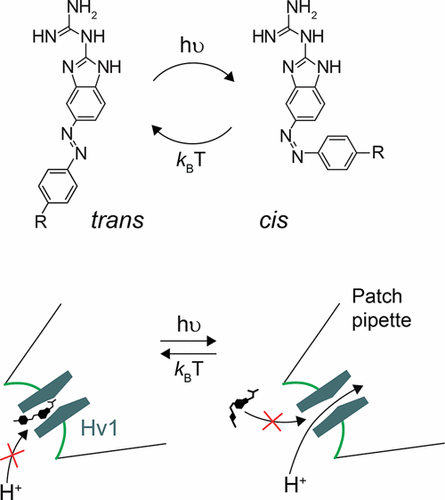当前位置:
X-MOL 学术
›
ACS Chem. Biol.
›
论文详情
Our official English website, www.x-mol.net, welcomes your feedback! (Note: you will need to create a separate account there.)
Photocontrol of the Hv1 Proton Channel
ACS Chemical Biology ( IF 4 ) Pub Date : 2017-11-07 00:00:00 , DOI: 10.1021/acschembio.7b00523 Andreas Rennhack 1 , Elena Grahn 1 , U. Benjamin Kaupp 1 , Thomas K. Berger 1
ACS Chemical Biology ( IF 4 ) Pub Date : 2017-11-07 00:00:00 , DOI: 10.1021/acschembio.7b00523 Andreas Rennhack 1 , Elena Grahn 1 , U. Benjamin Kaupp 1 , Thomas K. Berger 1
Affiliation

|
The voltage-gated proton channel Hv1 is expressed in various human cell types, including macrophages, epithelial cells, and sperm. Hv1 opening leads to proton efflux that alkalizes the cytosol. Here, we describe light-activated Hv1 inhibitors (photoswitches) that allow controlling its activity with high spatiotemporal precision. The photoswitches comprise a light-sensitive azobenzene moiety and 2-guanidinobenzimidazole (2GBI), a known Hv1 inhibitor. In the dark, photoGBI inhibits heterologously expressed Hv1 channels. Blue light, which isomerizes the azobenzene group from trans to cis conformation, releases inhibition. We demonstrate photocontrol of native proton currents in human macrophages and sperm using photoGBI, underlining their use as valuable optochemical tools to study the function of Hv1 channels.
中文翻译:

Hv1质子通道的光控
电压门控质子通道Hv1在各种人类细胞类型中表达,包括巨噬细胞,上皮细胞和精子。Hv1打开会导致质子外流,从而使细胞质碱化。在这里,我们描述了光激活的Hv1抑制剂(光开关),它可以以高时空精度控制其活性。光电开关包含光敏偶氮苯部分和2-胍基苯并咪唑(2GBI)(一种已知的Hv1抑制剂)。在黑暗中,photoGBI抑制异源表达的Hv1通道。蓝光,可将偶氮苯基团从反式转变为顺式构象,释放抑制作用。我们展示了使用photoGBI对人类巨噬细胞和精子中的天然质子电流进行光控制,强调了它们作为研究Hv1通道功能的有价值的光化学工具的用途。
更新日期:2017-11-08
中文翻译:

Hv1质子通道的光控
电压门控质子通道Hv1在各种人类细胞类型中表达,包括巨噬细胞,上皮细胞和精子。Hv1打开会导致质子外流,从而使细胞质碱化。在这里,我们描述了光激活的Hv1抑制剂(光开关),它可以以高时空精度控制其活性。光电开关包含光敏偶氮苯部分和2-胍基苯并咪唑(2GBI)(一种已知的Hv1抑制剂)。在黑暗中,photoGBI抑制异源表达的Hv1通道。蓝光,可将偶氮苯基团从反式转变为顺式构象,释放抑制作用。我们展示了使用photoGBI对人类巨噬细胞和精子中的天然质子电流进行光控制,强调了它们作为研究Hv1通道功能的有价值的光化学工具的用途。



























 京公网安备 11010802027423号
京公网安备 11010802027423号